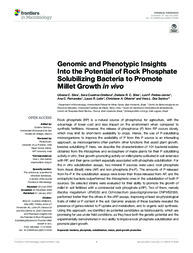Genomic and phenotypic insights into the potential of rock phosphate solubilizing bacteria to promote millet growth in vivo.
Genomic and phenotypic insights into the potential of rock phosphate solubilizing bacteria to promote millet growth in vivo.
Autoria: SILVA, U. C.; CUADROS-ORELLANA, S.; SILVA, D. R. C.; FREITAS-JÚNIOR, L. F.; FERNANDES. A. C.; LEITE, L. R.; OLIVEIRA-PAIVA, C. A.; SANTOS, V. L. dos
Resumo: Rock phosphate (RP) is a natural source of phosphorus for agriculture, with the advantage of lower cost and less impact on the environment when compared to synthetic fertilizers. However, the release of phosphorus (P) from RP occurs slowly, which may limit its short-term availability to crops. Hence, the use of P-solubilizing microorganisms to improve the availability of P from this P source is an interesting approach, as microorganisms often perform other functions that assist plant growth, besides solubilizing P. Here, we describe the characterization of 101 bacterial isolates obtained from the rhizosphere and endosphere of maize plants for their P solubilizing activity in vitro, their growth-promoting activity on millet plants cultivated in soil amended with RP, and their gene content especially associated with phosphate solubilization. For the in vitro solubilization assays, two mineral P sources were used: rock phosphate from Araxá (Brazil) mine (AP) and iron phosphate (Fe-P). The amounts of P released from Fe?P in the solubilization assays were lower than those released from AP, and the endophytic bacteria outperformed the rhizospheric ones in the solubilization of both P sources. Six selected strains were evaluated for their ability to promote the growth of millet in soil fertilized with a commercial rock phosphate (cRP). Two of them, namely Bacillus megaterium UFMG50 and Ochrobactrum pseudogrignonense CNPMS2088, performed better than the others in the cRP assays, improving at least six physiological traits of millet or P content in the soil. Genomic analysis of these bacteria revealed the presence of genes related to P uptake and metabolism, and to organic acid synthesis. Using this approach, we identified six potential candidates as bioinoculants, which are promising for use under field conditions, as they have both the genetic potential and the experimentally demonstrated in vivo ability to improve rock phosphate solubilization and promote plant growth.
Ano de publicação: 2021
Tipo de publicação: Artigo de periódico
Unidade: Embrapa Milho e Sorgo
Palavras-chave: Bactéria, Estimulante de Crescimento Vegetal, Fosfato, Milho, Solubilização
Observações
1 - Por padrão são exibidas publicações dos últimos 20 anos. Para encontrar publicações mais antigas, configure o filtro ano de publicação, colocando o ano a partir do qual você deseja encontrar publicações. O filtro está na coluna da esquerda na busca acima.
2 - Para ler algumas publicações da Embrapa (apenas as que estão em formato ePub), é necessário ter, no celular ou computador, um desses softwares gratuitos. Sistemas Android: Google Play Livros; IOS: iBooks; Windows e Linux: software Calibre.
Acesse outras publicações
Acesse a Base de Dados da Pesquisa Agropecuária (BDPA) para consultar o acervo completo das bibliotecas da Embrapa.

